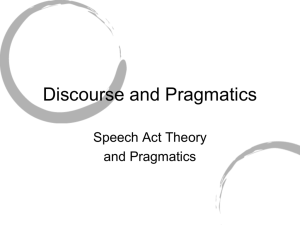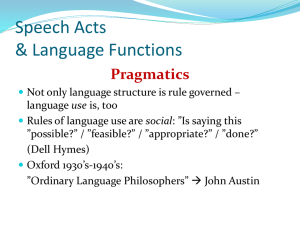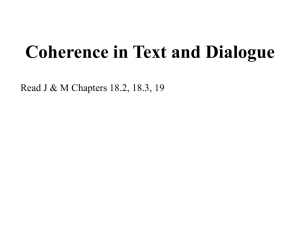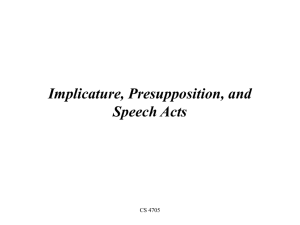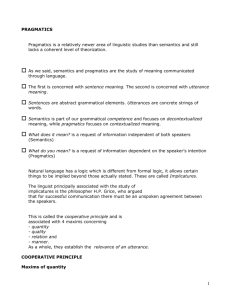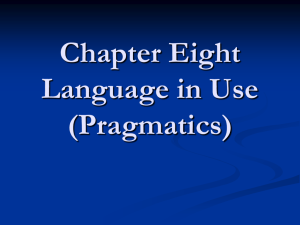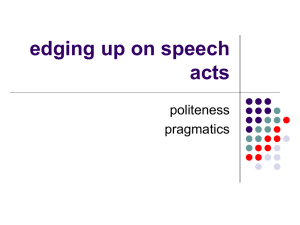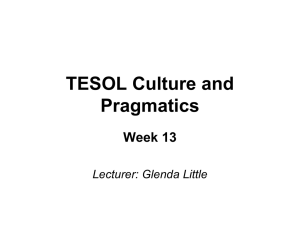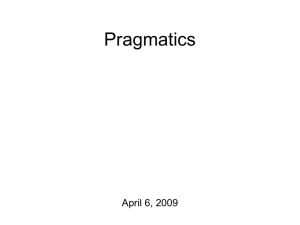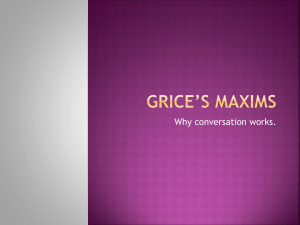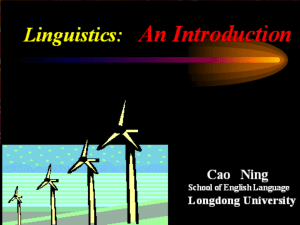Performatives施为句
advertisement
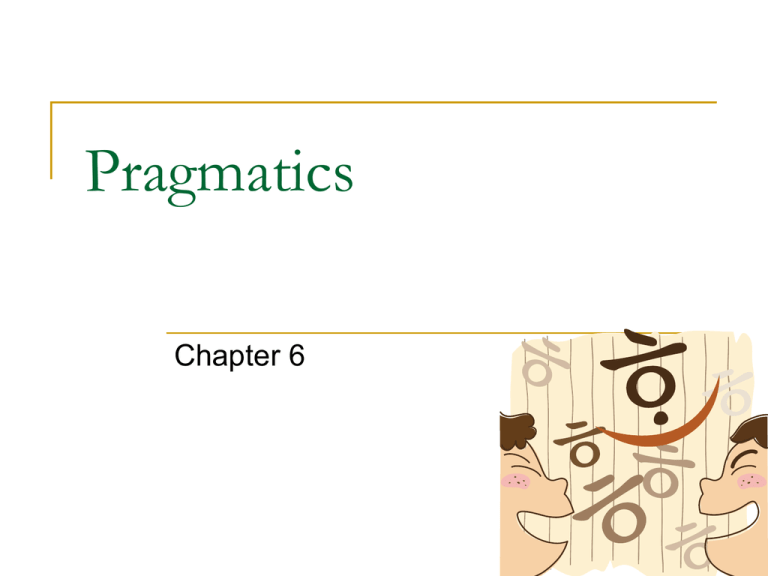
Pragmatics Chapter 6 I. Pragmatics vs. Semantics semantics + pragmatics =study of meaning Distinction: p. 161 Pragmatics Contextual Semantics 意会大于言传 Linguistic 我才是国足。 你才是国足。 该来的没有来,不该走的倒走了。 元芳,你怎么看? Man: Do you love me? Woman: Well, I like you.. (A father is trying to get his 3-year-old daughter to stop lifting up her dress to display her new underwear to others.) Father: We don’t DO that. Daughter: I KNOW, Daddy. You don’t WEAR dresses. 5 A little boy comes in the front door. Mother: Wipe your feet, please. He removes his muddy shoes and socks and carefully wipes his clean feet on the doormat. 6 II. Speech Act Theory 言语行为 John Austin (1911-1960) How to Do Things with Words (1962) 1. Definition: Speech Acts: actions performed via utterances 2. Categories Constatives 叙事句: utterances which roughly serves to state a fact, report that something is the case, or describe what something is, eg.: I go to the park every Sunday. I teach English. 8 Performatives施为句: utterances which are used to perform acts, do not describe or report anything at all; the uttering of the sentence is the doing of an action; they cannot be said to be true or false. Performative verbs: one that performs an action by speaking it, eg., name, bet, warn, etc. 9 I do. I name this ship Queen Elizabeth. I bet you sixpence it will rain tomorrow. I give and bequeath my watch to my brother. I promise to finish it in time. I apologize. I declare the meeting open. I warn you that the bull will charge. 10 3. Illocutionary Act Theory 行事行为/施为行为理论 Speech acts can be analyzed on 3 levels: Locutionary act Illocutionary act Perlocutiona -ry act 11 Level 1 A locutionary act 发话行为: the act of saying something in the full sense of “say”. 言内 Morning! 12 Level 2 An illocutionary act 行事行为: an act performed in saying something. To say something is to do something. 言外 In saying X, I was doing Y. 13 Morning! = She offered a greeting. 14 When we speak, we not only produce some units of language with certain meanings, but also make clear our purpose in producing them in the way we intend them to be understood, or they also have certain prefers to say. forces as Austin 语力 15 Level 3 The perlocutionary act 成事行为 By saying x and doing y, I did z (the words and actions will have effects on the hearer). 言外 A show of friendship OR An instance of hypocrisy 16 Illocutionary= in-locutionary X=I will come tomorrow. Y=许诺 In saying “I will come tomorrow”, I was making a promise. 17 Perlocutionary= By X=I will come tomorrow. Y=许诺 Z=By saying “I will come tomorrow” and making a promise, I reassure my friends. effect 18 Summary Locutionary act The physical action of uttering the sentence 发话行为 Illocutionary act The intention of the speaker 行事行为 The effects of Perlocutionar the sentence on y act the hearer 取效/成事 行为 19 Exercise Can you illocutionary recognize and the locutionary, perlocutionary act performed by the following utterance? 20 A wife says to her husband: “There’s no milk in the fridge.” Locutionary act: Uttering “There is no milk in the fridge.” Illocutionary act: Making a request: husband should go out and buy some. Offering an explanation: no milk left, so I will buy some. Perlocutionary act: Husband follows the request and buy some milk. Husband understands why his wife is ready to go out. Or he may suspect the reason his wife offers: is she really going out to get some milk? 21 There is a wasp in your ear. Locution: The speaker said this utterance. Illocution: He performs the act of warning. Perlocution: It may cause the hearer to panic, scream, or scratch one’s ear widely. Causing these emotions and actions is the perlocution. 4 Games have rules; so do speech acts. There are two different rules: Regulative rules(调节性规则) Constitutive rules(构成性规则) Conditions for (esp. illucotionary) Speech Acts (1) Essential conditions 合法 条件一:具备正常的语言输入与输出条件 双方都知道自己在做什么,不存在影响交际的生 理问题。 Ex.: Host: Get out of the house. Guest: I’m sorry. 基本条件 (2) Propositional conditions 条件二:说话人表达的命题合理——说话人就是 在讲述他将要实施的行为,说话人不可能允诺 别人会做什么。 Ex.: A: I’m sincerely sorry (that I broke your glass.) B: That’s ok. 命题条件 (3) Preparatory conditions 合算 a) b) 说话者有能力实施某行为; 所承诺的行为对听话者合算。 Ex.: Groom: I promise to take care of you no matter what. 准备条件 (4) Sincerity conditions 合情 说话人希望通过所说的话语使自己承担打算做 某事的责任。人们不会说“I promise to do…, but I do not intend to do it.”这样荒唐的话语。 Ex.: Groom: I promise to take care of you no matter what. 真诚条件 指令或请求行为 command 允诺或承诺言语 行动 promise 基本条件 说话人试图让听话 人做某事 做某事是说话人应 该承担的责任 命题条件 说话人讲出听话人 将要做的某事 说话人讲出自己将 要做的某事 准备条件 听话人能够实施某 事(行为) 说话人能够实施某 事,听话人希望说 话人实施某事 真诚条件 说话人希望听话人 做某事 说话人愿意做某事 Classification of Performative Speech Acts Explicit performatives 显性施为句 Implicit performatives 隐性施为句 Direct performatives 直接施为句 Indirect performatives 间接施为句 (Definition: an speech act in which an indirect relationship exists between the structure and the communicative function of an utterance.) Speech acts Constative performative Explicit Direct Conventional implicit Indirect Non-conventional I request that you speak a little louder 这个直接施为句是通过显性施为句的形式表现的。 Can you speak a little louder? 这个间接施为句是通过隐性施为句的形式表现的。 A. conventional indirect speech act 规约性间接言语行为: 按习惯可立即推断出间接 的“言外之意”。 Could you be a little more quiet? I’d rather you didn’t do it any more. Would you mind not making so much noise? I would appreciate it if you could turn off the light. B. non-conventional indirect speech acts 非规约性间接言语行为: 非规约性间接言语行为 较复杂和不稳定,主要依靠说话双方共知的语 言信息和所处的语境来推断。 A: Let’s go to the movie tonight. B: I have to study for the exam. III. The Cooperative Principle Herbert Paul Grice (1913-1988) Logic and Conversation (1975) 34 The Cooperative Principle (CP)合作原则 Grice’s theory is an attempt at explaining how a hearer gets from what is said to what is meant, from the level of expressed meaning to the level of implied meaning. 使你所说的话, 在其所发生的阶段, 符合你所参与的交谈 的公认目标或方向。 35 A woman is sitting on a park bench. A dog is lying on the ground in front of the bench. A man comes along and sits down on the bench. He starts to talk to the woman. Man: Does your dog bite? Woman: No. (The man reaches down to pet the dog. The dog bites the man’s hand.) Man: Ouch! Hey! You said your dog doesn’t bite. Woman: He doesn’t. But that’s not my dog. 36 Categories of maxims in CP QUANTITY QUALITY CP RELATION MANNER 37 Maxim of Quality: 质量准则/真实准则 Do not say what you believe to be false. Do not say something if you lack adequate evidence. Maxim of Quantity: 数量准则/适量准则 Make your contribution as informative as required (for the current purposes of the exchange). Do not make your contribution more informative than required. 38 Maxim of Relation: 相关准则 Be relative. Maxim of Manner: 方式准则/明晰准则 Be perspicuous. Avoid obscurity of expression. Avoid ambiguity. Be brief. Be orderly. 39 People tend to be cooperative and obey CP in communication. However, CP is often violated. Violation of CP and its maxims leads to conversational implicature (implied meaning). 40 Conversational implicature 会话含义/会话隐涵 Conversational implicature is comparable to illocutionary force in the speech act theory in that they are both concerned with the contextual side of meaning, or 言外之意 in Chinese. 41 Implicatures (p. 170) Conventional Non-conventional Conversational Non-conversational Generalized/standard Particularized Violation of the maxims (Quality) 1. Do not say what you believe to be false. You are the cream in my coffee. X runs as fast as a deer. He is made of iron. 43 Violation of the maxims (Quantity) 1. Make your contribution as informative as is required. A: 昨天上街买了些什么? B: 就买了些东西。 > I don’t want to tell you what I bought. 44 Dear Sir, Mr. X’s command of English is excellent, and his attendance at tutorials has been regular. Yours (Mr. X is applying for a leturership in philosophy.) > Mr. X is not suitable for the job. 45 2. Do not make your contribution more informative than is required. Aunt: How did Jimmy do his history exam? Mother: Oh, not at all well. Teachers asked him things that happened before the poor boy was born. > Her son should not be blamed. 46 A: Your kid broke the window. B: Boys are boys. > Boys are naughty by nature, so don’t blame him. A: A lot of soldiers died today. B: War is war. >War is cruel; there will be casualties and devastations. tautology 同义反复句 p. 175 47 Violation of the maxims (Relation) Be relevant. A: Prof. Wang is an old bag. B: Nice weather for the time of year. > I don’t want to talk about Prof. Wang. 48 萍:爸爸,不过四凤同鲁贵在家里都很好,很忠诚 的。 朴:恩,我很累了。 我预备到书房歇一下。你叫 他们送一碗浓一点的普洱茶来。 > 49 Violation of the maxims (Manner) 1. Avoid obscurity of expression A: Let’s get the kids something. B: Ok, but I veto C-H-O-C-O-L-A-T-E. > Don’t give them chocolate. 50 2. Avoid ambiguity A: Name and title, please? B: John Smith, Associate Editor and professor. Cf: 买一赠一。 51 3. Be brief A: Did you get my assignment? B: I received two pages clipped together and covered with rows of black squiggles. > not satisfied. 52 -Is your boss a nice man? - He wears a pink tie! - Have you finished the paper for semantics and the reading for pragmatics? - I ’ve done the paper. - Shall we invite Sam as well? - Well, Sam’s parents are with him now. - How did you like the hamburger? - Tina, hamburger is hamburger. 53 Exercises Looking at the following conversations, think about the questions below: 1. What maxim or maxims do you think speakers seem to flout? 2. How would the hearer infer the words? What implicatures would you draw? 54 Exercise 1 Mother: Where’s the cake? Jimmy: Lucy was just in the kitchen. Maxims of Relation 55 Exercise 2 Man: May I know your name? Woman: Diana Wang. And yours? Man: David. David Zhang. My friends all call me Dave. I am a director in a joint venture. I’m going to New York on a business trip next week. Maxims of Quantity &Relation & Manner 56 Exercise 3 Xiao Li is a bachelor with a good job and a handsome income. Mrs. Chen is thinking of doing a match-making for him and a friend’s daughter. She has the following conversation with Mrs. Yang, a colleague of Xiao Li: Mrs. Chen: That Xiao Li in your department looks like a nice guy. He isn’t married yet, is he? Mrs. Yang: Well, he’s from the countryside of Sichuan. He’s got five brothers and sisters and he’s the eldest. Maxims of Quantity and Relation 57 Characteristics of CP Inferability 可 推 导 性 : Hearers work out implicature based on literal meaning, CP and its maxims, context, etc. 58 Cancellability / defeasibility可取消性: If the linguistic or situational contexts change, the implicature will also change. A: Do you want some coffee? B1: Coffee would keep me awake. I do not like coffee. B2: Coffee would keep me awake. I want to stay up. Yes, I want coffee. 59 Open-endedness 开放性:An utterance may have different conversational implicatures depending on the different hypotheses made by the speaker and the hearer. John is a machine. John doesn’t use his brain to think. John is unemotional. John is always working without rest. Non-detachability不可分离性: Implicature is attached to the semantic content of what is said, not to the linguistic form; implicature does not vanish if the words of an utterance are changed for synonyms. A: Shall we go to the cinema tonight? B: There’ll be an exam tomorrow. I’ll take an exam tomorrow. Isn’t there an exam tomorrow? 61 IV. Politeness Principle Grice’s CP does not explain why speakers often violate CP . Geoffrey Leech: Professor of Linguistics and Modern English Language at Lancaster University from 1974 to 2002. Principles of Pragmatics (1983): puts forward PP to save CP. 62 Reason for violating rules: Face面子 “一个人在公众面前的自我形象 (the public self-image of a person)” 。 (Brown & Levinson, 1987) Do not offend others. Be nice to others. 63 面子的正面和负面 正面面子(positive face)---- refers to our need to be accepted, even liked, by others and our need to be treated as a member of a group and to know that our wants are shared by others of the same group. 我们都需 要被别人接受甚至喜欢,需要被某个团体接纳为一员, 需要确知我们的所求与我们所属团体中其他成员的所求 一致。 负面面子(negative face)---- refers to our need to be independent, to have freedom of action, and not to be imposed on by others. 我们同时还需要独立,需要享有行动的自由,需要免受 他人的干扰。 64 威胁与保护面子 威胁到听话人的面子需求的话语—威胁面子的行为 (face-threatening act)。 旨在减轻对听话人的面子需求的威胁的话语– 保护 面子的行为(face-saving act) --Stop that awful noise right now! --The music is very nice. But it’s getting a bit late and people need to get to sleep. Are you going to stop soon? 65 Politeness Principle: (Leech) Politeness in communication requires us to adopt strategies of (a) maximizing “ polite beliefs” and (b) minimizing “ impolite beliefs.” Tact Maxim Generosity Maxim Approbation Maxim Modesty Maxim Agreement Maxim Sympathy Maxim 66 Self(自身)----refers to the speaker. Other (他人)----refers to the addressee or a third person, present or not. Benefit (惠) & Cost (损) Generally speaking, if there is benefit, there must be cost. 67 Tact Maxim得体准则 a) Minimize cost to other b) Maximize benefit to other ] Generosity Maxim宽宏准则 a) Minimize benefit to self b) Maximize cost to self ] 68 A: Oh, my bag is so heavy! B: Do you need any help? C: Let me help you. 69 Approbation Maxim赞誉准则 a) Minimize dispraise of other b) Maximize praise of other Modesty Maxim谦虚准则 a) Minimize praise of self b) Maximize dispraise of self 70 A:How is my suit? B:It’s ugly. C: It’s OK. But I think the color is too dark on you. A:今天真倒霉! B:我说的吧,自找的。 C: 过去就算了,别再想啦。 71 Agreement Maxim一致准则 a) Minimize disagreement between self and other b) Maximize agreement between self and other Sympathy Maxim同情准则 a) Minimize antipathy between self and other b) Maximize sympathy between self and other 72 A: Let’s go to movies tonight. B: No. I don’t feel like going. C: I wanted to go, but I have to study for my exam. Student: I’m sorry. I couldn’t work it out. Teacher1: Of course. You are so stupid. Teacher2: That’s Ok. This problem is difficult for most students. 73 Politeness Principle’s Basis A: We’ll miss Bill and Agatha, won’t we? B: Well, we’ll all miss Bill. (violation of quantity maxim) 74 Pragmatic scales for politeness (175) Another important aspect of Leech’s concept of politeness is pragmatic scales: the cost-benefit scale the optionality scale the indirectness scale
